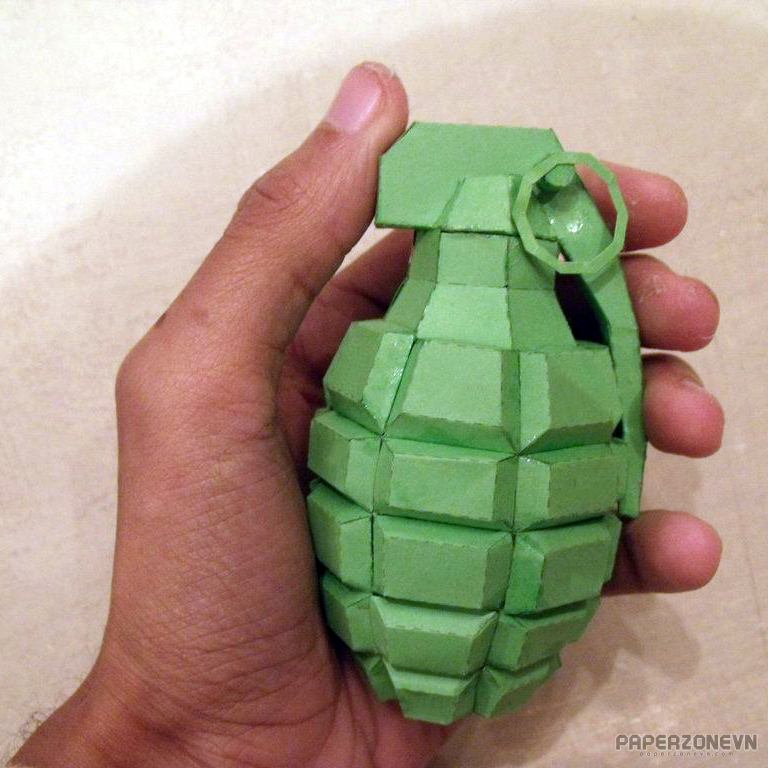- Thumbnail
-

- Resources
- wongday.blogspot.com
- Author
- Wong Hidayat
- Printed File Format
- Page(s)
- 2
- Part(s)
- 49
- Instruction Format
- PDO
Sponsored:
Sponsored 2:
Grenade papercraft
Dimensions: 101 x 65 x 56 mm

Dimensions: 101 x 65 x 56 mm

A grenade is an explosive weapon typically thrown by hand (also called hand grenade), but can also refer to a shell (explosive projectile) shot from the muzzle of a rifle (as a rifle grenade) or a grenade launcher. A modern hand grenade generally consists of an explosive charge ("filler"), a detonator mechanism, an internal striker to trigger the detonator, and a safety lever secured by a linchpin. The user removes the safety pin before throwing, and once the grenade leaves the hand the safety lever gets released, allowing the striker to trigger a primer that ignites a fuze (sometimes called the delay element), which burns down to the detonator and explodes the main charge.
Grenades work by dispersing fragments (fragmentation grenades), shockwaves (high-explosive, anti-tank and stun grenades), chemical aerosols (smoke and gas grenades) or fire (incendiary grenades). Fragmentation grenades ("frags") are probably the most common in modern armies, and when the word grenade is used in everyday speech, it is generally assumed to refer to a fragmentation grenade. Their outer casings, generally made of a hard synthetic material or steel, are designed to rupture and fragment on detonation, sending out numerous fragments (shards and splinters) as fast-flying projectiles. In modern grenades, a pre-formed fragmentation matrix inside the grenade is commonly used, which may be spherical, cuboid, wire or notched wire. Most anti-personnel (AP) grenades are designed to detonate either after a time delay or on impact.
Grenades are often spherical, cylindrical, ovoid or truncated ovoid in shape, and of a size that fits the hand of a normal adult. Some grenades are mounted at the end of a handle and known as "stick grenades". The stick design provides leverage for throwing longer distances, but at the cost of additional weight and length, and has been considered obsolete by western countries since the World War II and Cold War periods. A friction igniter inside the handle or on the top of the grenade head was used to initiate the fuse.
Grenades work by dispersing fragments (fragmentation grenades), shockwaves (high-explosive, anti-tank and stun grenades), chemical aerosols (smoke and gas grenades) or fire (incendiary grenades). Fragmentation grenades ("frags") are probably the most common in modern armies, and when the word grenade is used in everyday speech, it is generally assumed to refer to a fragmentation grenade. Their outer casings, generally made of a hard synthetic material or steel, are designed to rupture and fragment on detonation, sending out numerous fragments (shards and splinters) as fast-flying projectiles. In modern grenades, a pre-formed fragmentation matrix inside the grenade is commonly used, which may be spherical, cuboid, wire or notched wire. Most anti-personnel (AP) grenades are designed to detonate either after a time delay or on impact.
Grenades are often spherical, cylindrical, ovoid or truncated ovoid in shape, and of a size that fits the hand of a normal adult. Some grenades are mounted at the end of a handle and known as "stick grenades". The stick design provides leverage for throwing longer distances, but at the cost of additional weight and length, and has been considered obsolete by western countries since the World War II and Cold War periods. A friction igniter inside the handle or on the top of the grenade head was used to initiate the fuse.
Sponsored: Google Advertising
